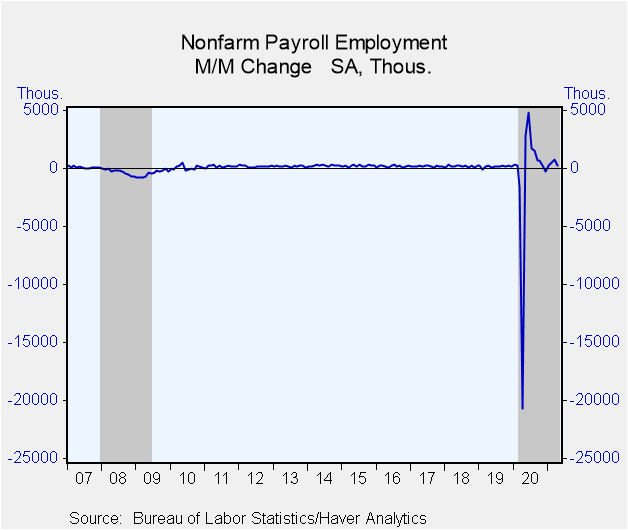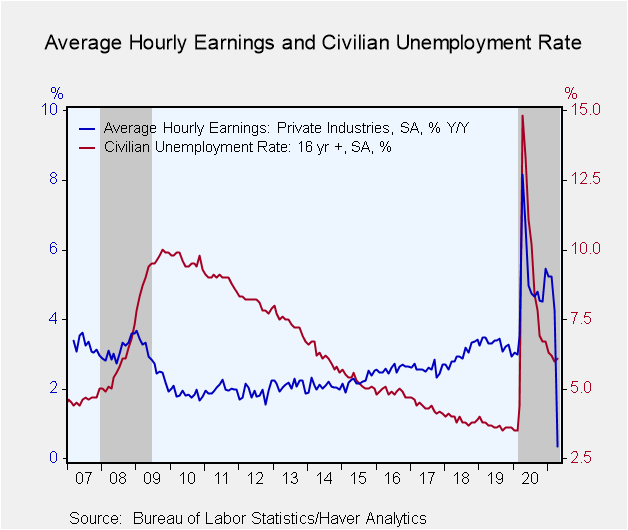 Global| May 07 2021
Global| May 07 2021U.S. Payrolls Greatly Disappoint in April; Earnings Strengthen, While Jobless Rate Edges Higher
by:Tom Moeller
|in:Economy in Brief
Summary
• Weakness in hiring is broad-based. • Average hourly earnings rebound, reversing March decline. • Unemployment rate edges up from twelve-month low. Strength in the labor market waned following the initial lift from business re- [...]
• Weakness in hiring is broad-based.
• Average hourly earnings rebound, reversing March decline.
• Unemployment rate edges up from twelve-month low.
Strength in the labor market waned following the initial lift from business re-openings and COVID-19 vaccines. Nonfarm payroll employment increased 266,000 (10.9% y/y) during April. A 950,000 rise had been expected in the Action Economics Forecast Survey. It was the weakest increase in three months. The unexpectedly smaller gain was accompanied by a downward revision to the March increase to 770,000 from 916,000. February's gain was revised to 536,000 from 468,000.
Average hourly earnings strengthened 0.7% last month (0.3% y/y) after easing an unrevised 0.1% in March. It was the largest increase since December and compared to expectations for stability.
The unemployment rate rose to 6.1% in April from 6.0% in March, compared to expectations for a decline to 5.8%. Employment in the household survey grew 328,000 last month after rising 609,000, while the labor force rose 430,000 after a 347,000 gain. The overall unemployment rate, including those who were marginally attached or working part-time for economic reasons, fell to 10.4% from 10.7%. It was the lowest level since March of last year.
The employment & earnings data are collected from surveys taken each month during the week containing the 12th of the month. The labor market data are contained in Haver's USECON database. Detailed figures are in the EMPL and LABOR databases. The expectations figures are in the AS1REPNA database.
| Employment (SA, M/M Change, 000s) | Apr | Mar | Feb | Apr Y/Y | 2020 | 2019 | 2018 |
|---|---|---|---|---|---|---|---|
| Payroll Employment | 266 | 770 | 536 | 10.9% | -5.8% | 1.3% | 1.6% |
| Previous Estimate | -- | 916 | 468 | -- | -- | -- | -- |
| Manufacturing | -18 | 54 | 35 | 7.7 | -5.0 | 1.0 | 2.0 |
| Construction | 0 | 97 | -57 | 14.3 | -3.0 | 2.8 | 4.6 |
| Private Service-Producing | 234 | 542 | 642 | 14.0 | -6.6 | 1.4 | 1.5 |
| Government | 48 | 62 | -86 | -1.0 | -3.1 | 0.7 | 0.5 |
| Average Weekly Hours - Private Sector | 35.0 | 34.9 | 34.6 | 34.2 | 34.6 | 34.4 | 34.5 |
| Private Sector Average Hourly Earnings (%) | 0.7 | -0.1 | 0.3 | 0.3 | 4.8 | 3.3 | 3.0 |
| Unemployment Rate (%) | 6.1 | 6.0 | 6.2 | 14.8 | 8.1 | 3.7 | 3.9 |
Tom Moeller
AuthorMore in Author Profile »Prior to joining Haver Analytics in 2000, Mr. Moeller worked as the Economist at Chancellor Capital Management from 1985 to 1999. There, he developed comprehensive economic forecasts and interpreted economic data for equity and fixed income portfolio managers. Also at Chancellor, Mr. Moeller worked as an equity analyst and was responsible for researching and rating companies in the economically sensitive automobile and housing industries for investment in Chancellor’s equity portfolio. Prior to joining Chancellor, Mr. Moeller was an Economist at Citibank from 1979 to 1984. He also analyzed pricing behavior in the metals industry for the Council on Wage and Price Stability in Washington, D.C. In 1999, Mr. Moeller received the award for most accurate forecast from the Forecasters' Club of New York. From 1990 to 1992 he was President of the New York Association for Business Economists. Mr. Moeller earned an M.B.A. in Finance from Fordham University, where he graduated in 1987. He holds a Bachelor of Arts in Economics from George Washington University.








